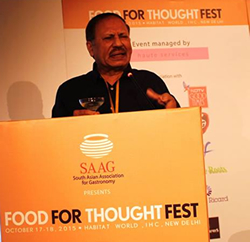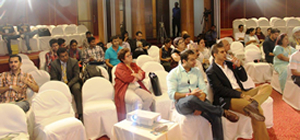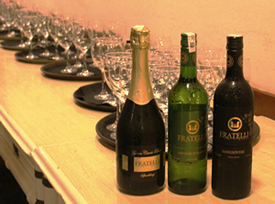|
Photos By:: Adil Arora
 Most conferences on food or gastronomy focus only on food. It was perhaps the first time that wine was included in such a conference, said Arora while raising a toast to the organisers for having the foresight to include wine- a food product and an important part of gastronomy and gourmet meals. He compared the two with the union of man and woman to make one complete entity. As he started to trace the history of Modern Indian Wines, he had the audience raise a toast also to Fratelli Vineyards which supported the tasting and whose two wines have been singularly chosen by Selfridges in UK- the ‘best department store in the world’, currently running the ‘Selfridges Loves India’ promotion. Most conferences on food or gastronomy focus only on food. It was perhaps the first time that wine was included in such a conference, said Arora while raising a toast to the organisers for having the foresight to include wine- a food product and an important part of gastronomy and gourmet meals. He compared the two with the union of man and woman to make one complete entity. As he started to trace the history of Modern Indian Wines, he had the audience raise a toast also to Fratelli Vineyards which supported the tasting and whose two wines have been singularly chosen by Selfridges in UK- the ‘best department store in the world’, currently running the ‘Selfridges Loves India’ promotion.
Talking about the history of modern Indian wines-Indian wine has arrived!
History
Arora chose to divide the History of Modern Indian Wines in three sections- Mythological, Historical and Modern.
Mythological: India is known to have produced some kind of wine during the Indus Valley Civilization (2600-1900 BC), around 4000 years ago. The Hindu Gods are described as drinking an alcoholic drink known as Sura that appears to have been a rice fermented product with honey in it. Lord Indra apparently loved a wine-like beverage. There is mention of meat and ‘wine’ being served at the wedding of Lord Shiva with Parvati. There is a record of wine in Rig Veda, described as Soma Rasa (juice from the vines).
Chanakya, the wise and wily Prime Minister of King Chandragupta Maurya in the 4th millennium BC, is known to have been an anti-alcoholic. He described with disdain about nobles indulging in nefarious activities like drinking an intoxicating beverage made from the fermentation of grapes.
Historical
There is a lot of evidence about the Mughal kings drinking wine (Shiraz) imported from Persia. Persian traders are also known to have brought their vines to India even prior to that. The European visitors to the courts of Akbar, Jehangir and Shahjehan in the 16th and 17th century are described as having been served wine from the Royal vineyards and were impressed by the wines made from grapes in Hyderabad, Surat and Baramati in Maharashtra. Arkesham, the local red grape variety was used to make the red wines while Arkawati and Bhokry were used to make white wines. The British who colonised India also encouraged the viticulture to have local wines.
During the 16th century the Portuguese also colonised Goa and started the production of ‘Goan Port’-the fortified wine which has taken deep roots and today wines in this genre occupy half of the wine industry-known as Goan Port, Port or simply fortified wine. This form of viticulture spread to the other Indian States as well and because of its low cost the growth has been faster.
The Nineteenth century saw Indian wines reach their pinnacle during this period. In the Great Calcutta International Exhibition of 1883-84 that closed in March 1884, Indian wines found a favourable response from the visitors, according to records available. Barely a few years later, in 1890 the infamous phylloxera-the louse attack that killed the European vines hit India as well and wiped out the whole of grape cultivation. Due to the social opposition, the replanting was not encouraged by the British in the 20th century.
After Independence in 1947, the newly written Constitution urged the States to introduce prohibition and there was thus no viticulture for grapes for wine though eating grapes and raisin grapes continued to be grown. Thanks to this sector, India is the world’s 9th largest the grape producer today, according to OIV-the international Organisation of Wines and Vines in Paris.
Historically, Ayurvedic medicines have also been using wine as the ingredient for various cures. Draksharishtha, an old Indian wine, is made of grape juice and herbs, but without any micro-filtration process used in modern winemaking. Even now Draksharishtha is prescribed by Ayurvedic doctors as a medicine. It has 7-11% alcohol by volume. Dabur, Baidyanath, Arya Vaidyasala etc., well-known makers of Ayurvedic  medicines and concoctions make and sell this product prescribed for various ailments. medicines and concoctions make and sell this product prescribed for various ailments.
Modern
With States loosening the grip on a total prohibition, low-end fortified wines like Golconda by Shaw Wallace and Bosca by UB came into existence in the 1970s. The cottage industry was popular in Goa but Vinicola and Tonia set up new units in the organised sector around the early 1980s.
Champagne Indage was the pioneer of the modern Indian industry with Shyam Chougule bringing out the sparkling wine Marquis de Pompadour in 1984 with the help of a French Champagne house. Due to the export commitment for the project, it was exported to several countries as Omar Khayyam. One fourth of the production was soon allowed to be sold in the local market. Made basically from Thompson Seedless eating grapes (the company always claimed they used Chardonnay and Pinot Noir), it became very popular in the Indian market. Later, they expanded into several table and fortified wines and remained the number one producer till 2008. See a related earlier article
Grover Vineyards was founded in 1988 by the late Kanwal Grover in Bangalore and is credited for introducing wines from wine grapes like Shiraz, Cabernet Sauvignon and Clairette. They ruled the roost for premium wines till they were overtaken by the third pioneer Sula in the early 2000s. Today they are no. 2 in value as well as volume production in the premium wine segment. They merged with another entrant later- Zampa Wines (Vallée di Vin).
Sula Vineyards followed Grover in 1999-2000 which was then the no. 2 winery in size. With Chateau Indage (later Indage Vintners ) running into financial trouble and later going bankrupt, Sula became the no. 1 producer in 2009 and continues to lead today.
First Wave
Several small wineries soon came into existence when the Maharashtra government came out with an attractive excise policy in 2001-bringing all administrative permissions under one-window scheme and with several monetary benefits. Fuelled by subsidies, a plethora of smaller wineries came into existence-like York, Vintage, Vinsura, and Flamingo. Several others including Zampa, Four Seasons, Nine Hills and Vallonne followed. Big Banyan was the lone exception in Goa.
Second Wave
Around 2008, modern wineries like Chateau d’Ori, Fratelli, Charosa, came into existence in Maharashtra. It is these wineries that are making efforts to make Brand India move forward though with limited success as some of them fell into the trap of financial constraints. Karnataka formed its new excise policy in 2008, encouraging several new wineries to be set up there. During this period several entrepreneurs with passion and deep pockets also came into being-these included KRSMA, Alpine, SDU and Myra among several others.
Fratelli Vineyards were the first Indo-Italian equity venture and quickly established their mark because of quality aspirations and aggressive marketing. Today, they are no. 3 in the hierarchy and striving to grab the no. 2 spot.
Chandon sparkling wine came into existence in 2013. Owned by Moet Hennessey India, this winery is the latest one in the Indian wine history -to be inaugurated on November 27 in Nashik.
Wine Tasting
Keeping in tune with the topic of the day, I selected three wines representative of 3 different phases of modern wine making during the last 30 years. This also implied a wide spectrum that included a Sparkling, white and a red wine, with different grapes in all three: Grand Cuvee Brut, Sauvignon Blanc and Sangiovese.
 Fratelli Grand Cuvee Brut is the sparkling wine, quintessential in the history of modern Indian wine-making representing Marquis de Pompadour, the first Indian wine launched in 1984-85. This is also representative of Champagne- the celebratory drink which was served as the talk started-both as a welcome drink for the audience and as a toast to the organisers SAAG for organising the first-ever FoodforThought Fest. Fratelli Grand Cuvee Brut is the sparkling wine, quintessential in the history of modern Indian wine-making representing Marquis de Pompadour, the first Indian wine launched in 1984-85. This is also representative of Champagne- the celebratory drink which was served as the talk started-both as a welcome drink for the audience and as a toast to the organisers SAAG for organising the first-ever FoodforThought Fest.
This Chenin Blanc-based wine with a second fermentation in the bottle has a zero dosage, i.e., no sugar is added at the end and it is totally dry. People either love it or dislike. It was a pleasant surprise that the majority in the audience said they really liked it, with only one exception.
Fratelli Sauvignon Blanc represents the success of the first Indian white wine made from the international wine grapes, introduced by Sula in 2000. This wine was aromatic with notes of green pepper, capsicum and asparagus with herbaceous notes, full on the palate and with a long end.
Fratelli Sangiovese is the modern interpretation of experimenting with foreign grapes-Italian in this case and representing the partner country Italy from where a third of the brother duos belong. Floral aromas, softer tannins and higher acidity along with the clean and fruity flavours were appreciated by the audience.
Trivia: Power of Three
It was an interesting coincidence that the Seminar had number three repeat itself more than thrice.
-The History of Wine was divided into 3 parts- Mythological (2000 BC-1500 AD), Historical (appx.1500- 1984) and Modern (1985-2015)
-The Modern History was compartmentalised in 3 sections- Pioneer (1985-2000), First Wave (2000-2008), Second Wave (2008-215)
-Wines for tasting were selected from Fratelli Vineyards (3 sets of brother duo partners)
-I selected 3 wines-representing the range of style (Sparkling, White and Red)
-I selected 3 different grape varieties- Chenin (sparkling), White (Sauvignon Blanc) and Red (Sangiovese)-no grape variety was repeated so the audience could taste a wide spectrum within the constraints.
The session went well past the schedule due to a plethora of questions by the audience who opened up to the inimitable style of Arora and with a glass of bubbly in the stomach. The highlight of the talk was Nikhil Chopra, one of the VIP guests- a former test cricketer, who said he did not care much for Indian wines at the start but changed his mind after the seminar. Bishen Singh Bedi, the legendary spin bowler admitted he was not a wine drinker but was educated and motivated enough by the talk to start drinking some wine on a regular basis.
The wine service by the IHC staff was commendable. But every time I have a glass of wine there with their toy glasses used today also, I wonder when they are going to buy and use real wine glasses and what stops them from coming out of the primitive age. Much smaller restaurants in Delhi have switched to proper stemware since long. It is high time IHC makes the small investment in proper glasses.
Subhash Arora |